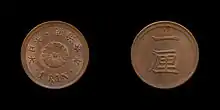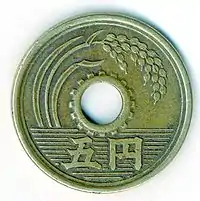1 rin coin
The one rin coin (一厘銅貨) was a Japanese coin worth one one-thousandth of a Japanese yen, as 1 rin equalled 1⁄10 sen, and 100 sen equaled 1 yen.[1] While not in circulation any more, one rin coins are bought and sold by numismatists for academic study, and by those with a hobby.
Japan | |
| Value | 1⁄1000 Japanese Yen |
|---|---|
| Mass | 0.91 g |
| Diameter | 15.75 mm |
| Edge | Smooth |
| Shape | Circular |
| Composition | 98% Copper 2% Tin and Zinc |
| Years of minting | 1873–1884 1892 |
| Obverse | |
| Design | Chrysanthemum crest above "1 Rin", legends separated by dots above. |
| Design date | 1873 |
| Reverse | |
| Design | Value and denomination |
| Design date | 1873 |
History
One rin coins were first minted in 1873 shortly after Japan adopted a new currency system under the Meiji Restoration.[2] These coins were approximately equal to a one mon coin of the old currency system.[3] Meanwhile in the new yen based currency system the rin was the lowest denomination coin valued at one-one thousandth of a yen. All one rin coins are made from a bronze alloy, and are five-eights of an inch (15.75mm) in diameter with a weight of fifteen grains (0.9g).[4] Production of one rin coins slowed by the middle of 1875, it was noted by the commissioner of the Imperial Mint that "there has been no lack of work in the department, on account for demand of copper coins, the whole of the coining-presses, excepting those for rin, having been daily in full operation".[5] No coins were minted from 1878 to 1881 with the exception of 810 listed pieces being struck in 1880 for regular circulation.[6] While coinage resumed in 1882 it was short lived as the rin was last minted for circulation in 1884. Factors for the one rin coin's demise included inconvenience due to their small size.[7]
One rin coins were later struck in 1892 (year 25) to have non circulating examples to display at the World's Columbian Exposition.[8] It was noted by 1904 that a rin was worth 1⁄10 of a farthing or 1⁄20 of an American penny.[9] All one rin coins were eventually taken out of circulation at the end of 1953 and demonetized. The Japanese government passed a new law during this time that abolished subsidiary coinage in favor of the yen.[10]
Circulation figures

Meiji
The following are circulation figures for the one rin coin, all of which were minted between the 6th, and 25th year of Meiji's reign. The dates all begin with the Japanese symbol 明治 (Meiji), followed by the year of his reign the coin was minted. Each coin is read clockwise from right to left, so in the example used below "七十" would read as "year 17" or 1884.
- "Year" ← "Number representing year of reign" ← "Emperors name" (Ex: 年 ← 七十 ← 治明)
| Year of reign | Japanese date | Gregorian date | Mintage |
|---|---|---|---|
| 6th | 六 | 1873 | 6,979,260[11] |
| 7th | 七 | 1874 | 4,881,630[12] |
| 8th | 八 | 1875[lower-alpha 1] | 3,718,840[11] |
| 9th | 九 | 1876 | 23,000[11] |
| 10th | 十 | 1877 | |
| 13th | 三十 | 1880 | 810[11] |
| 15th | 五十 | 1882 | 3,632,360[11] |
| 16th | 六十 | 1883 | 14,128,150[11] |
| 17th | 七十 | 1884 | 16,009,130[11] |
| 25th | 五十二 | 1892 | Not circulated[lower-alpha 2] |
Collecting
Common dates for the one rin coin can usually be found online, and at pawn shops where prices vary depending on the condition of the coin.[13] Outside of the common dates are four coins which are considered to be rarities that sell for larger amounts. Coins dated 1876 (year 9) are described as "one of the two major regular issue 1 rin rarities[lower-alpha 3]", and an AU58 example brought $12,075.00 (USD) in 2011.[14][15] The following date 1877 (year 10) is also considered to be "very rare", but sold for a lesser amount.[16] While coins dated 1880 (year 13) have a recorded mintage of 810 pieces, the actual amount struck is thought to be less.[14] One example in AU58 condition sold for a similar amount as the 1876 dated coin at the same venue in 2011.[17] The final of the four rarities are coins dated 1892 (year 25) which were used for display in Chicago. One of the few surviving examples in mint state condition sold at the same venue in 2011 for $63,250,00. (USD)[18] Certification is recommended overall, as one rin coins have a simplistic design that has made them a target of counterfeiters.[19]
Notes
- Two different varieties exist that have the character "MEI" being separate versus connected. Their mintage is combined in the following column.
- 1892 dated coins were never intended for circulation as they were made for the World's Columbian Exposition as exhibits.[8]
- Along with 1880 (year 13) dated coins.
References
- John Crowdy (1873). "The British Almanac". Stationers' Company. pp. 112–113. Retrieved December 9, 2016.
- A. Piatt Andrew, Quarterly Journal of Economics, "The End of the Mexican Dollar", 18:3:321–356, 1904, p. 345
- Akin, Marjorie H.; Bard, James C.; Akin, Kevin (2016). "Japanese Coins Exported to China and Beyond". Numismatic Archaeology of North America. Taylor & Francis.
- "1厘銅貨" (in Japanese). www.buntetsu.net. Retrieved December 10, 2016.
- John Percival Jones (1876). "Monetary System in Japan". Report and Accompanying Documents of the United States Monetary Commission, Organized Under Joint Resolution of August 15, 1876. United States Monetary Commission. p. 350.
- "Japan: Meiji Proof 1/2 Sen Year 13 (1880)". Heritage Auctions. Retrieved September 12, 2020.
- A.H. Blackwell (1892). Rin Abolished. 18. The Japan Daily Mail. p. 271. Retrieved January 9, 2019.
- "Japan: Meiji copper 1 Rin Year 25 (1892), struck for exhibit at the Worlds Columbian Exposition in Chicago in 1892". Heritage Auctions. Retrieved September 8, 2020.
- Walter Del Mar (1904). Around the World Through Japan. A. and C. Black. p. 136. Retrieved June 12, 2017.
Japan one rin coin.
- "小額通貨の整理及び支払金の端数計算に関する法律" [A law of the abolition of currencies in a small denomination and rounding off a fraction, July 15, 1953 Law No.60]. www.shugiin.go.jp. Archived from the original on June 28, 2002. Retrieved December 5, 2016.
- "Japan Rin Y# 15 Yr.10(1877)-Yr.9(1876)". Numismatic Guaranty Corporation. Retrieved December 10, 2016.
- "Japan Weekly Mail". Jappan Meru Shinbunsha. 1875. Retrieved December 10, 2016.
- "1 rin coin". eBay. Retrieved December 11, 2016.
- "M9(1876) JAPAN RIN MS Coin Auctions". Numismatic Guaranty Corporation. Retrieved September 8, 2020.
- "Meiji copper 1 Rin Year 9 (1876)". Heritage Auctions. Retrieved September 8, 2020.
- "Meiji copper 1 Rin Year 10 (1877)". Heritage Auctions. Retrieved September 8, 2020.
- "M13(1880) Japan Rin MS Coin Auctions". Numismatic Guaranty Corporation. Retrieved September 12, 2020.
- "M25(1892) Japan Rin MS Coin Auctions". Numismatic Guaranty Corporation. Retrieved December 11, 2016.
- "1厘硬貨の買取価値と概要について". Kosen Kaitori (in Japanese). Retrieved September 8, 2020.
